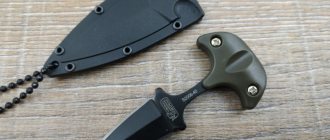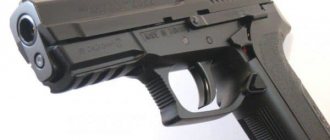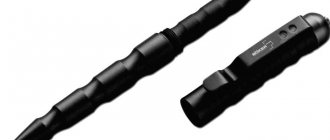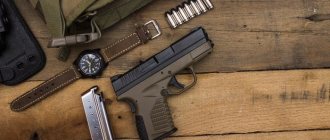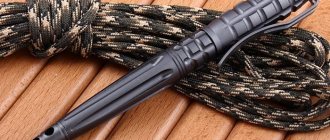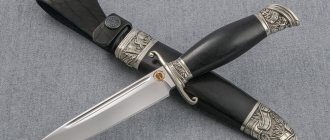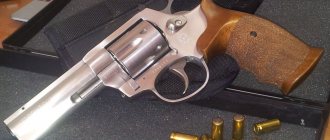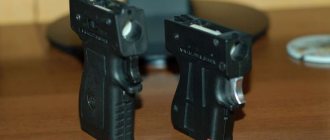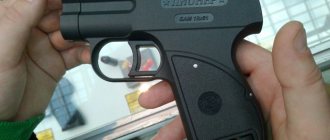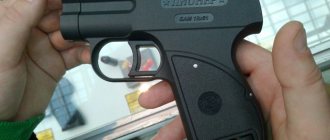The most affordable and popular weapon for self-defense is a knife. Knives, as bladed weapons, have been used for centuries; hundreds and thousands of different versions of this bladed weapon have been created. One of them is the hero of this article – a butcher knife.
The blade is small in size, so it is quite compact, and manufacturers of modern accessories often build it into utilitarian items - purses, belt buckles, wallets, and so on. At the same time, a butcher knife in skillful hands can cause terrible wounds.
History of origin
Models of butting knives that resemble modern ones appeared back in the 19th century. Researchers still cannot say which instrument became the example for their creation. However, it is very similar to the claws and Indian catarrh that ninjas readily used.
Almost 200 years ago, a poke knife was the favorite tool of card sharpers, of whom there were quite a lot at that time. They used the tool when someone encroached on the money earned during the game. To use a bayonet, no special skills were required; it was enough to hold the tool in your fist and have a basic understanding of striking techniques.
History of creation
Today we cannot say exactly who and when first came up with the idea that the blade does not necessarily have to continue the handle of the knife or sword. However, this happened quite a long time ago. This type of bladed weapon design is first encountered in the East, or more precisely in India. It was there that the Katara daggers, well known to historians, as well as the Pata swords appeared. The concept of this weapon was similar: its blade was located perpendicular to the handle, which was clamped in the fist. Additional fixation of the weapon was provided by branches of the guard or simply leather belts, with which, for example, the catarrh was simply tied to the forearm.
As mentioned above, modern push dagger actually originated in the United States. There is no doubt about this, but it is not entirely clear how this happened.
There is a hypothesis that its prototype was the traditional Eskimo knife ulu, which they used for skinning and other household needs.
According to another version, the idea of creating a push-dagger came to the United States from the East along with emigrants. “Asian” motifs are too clearly visible in the stab knife.
Push-daggers came into use during the development of the Wild West and the famous American Gold Rush. At this time, the United States was flooded with adventurers, rogues, and even simply seekers of a better life from various countries of the world. Of course, among them there were also emigrants from the East who might have been familiar with the ideas of Indian gunsmiths.
They say that initially the stab knife became popular not among tough cowboys or gold miners, but among parlor card sharpers and petty urban criminals. Very similar to the truth. For a cowboy or prospector, a Bowie knife is much more suitable, with which you can cut a steak and kill your opponent in a fight. A push-dagger is a weapon exclusively for fighting; it is almost impossible to use it for economic purposes. In addition, a butcher knife is a very small thing that can be carried with you unnoticed and used as a last resort.
One of the first butting knives to appear in the CIS was the Taganka push-dagger, which was released by . This weapon has become so popular that now “Tagankas” are often called any butcher knives.
Features of design and application
A small butcher knife is L- or T-shaped. It is characterized by a blade located perpendicular to the handle. It usually has a shape similar to a dagger, with the blade sharpened on both sides.
Typically, the length of the weapon is within 15 cm, but there are also models of smaller sizes, up to 8 cm. The average thickness is about 0.5 cm, due to which it does not deform upon impact.
To make a knife, high-quality steel is used, although nowadays there are also models made of plastic. They are lightweight, which does not affect their performance in any way.
The handle is made of plastic or metal, less often from wood. Its main function is to conveniently support the weapon in the palm. Based on this, it is important to be responsible when choosing a handle. It is better to choose a model that has pads, as they are considered more comfortable.
This knife does not have a guard; instead there are special grooves for fingers. The average weight is in the range of 50-100 grams.
Typically, butcher knives are equipped with a sheath; they are usually made from leather, wood or plastic. The push-dagger is held in a fist like brass knuckles. The T-shaped blade should be placed between the middle and ring fingers, the L-shaped blade should be placed between the index and middle fingers.
Special purpose knife Grand Way.
Steel for production
Since the task of a push dagger is not to cut food or plane wood, the steel used to make it generally does not have outstanding characteristics. The blade of a butcher knife must have the following qualities:
- Stainless steel;
- The thickness of the blade should prevent its accidental breakage;
- The sharpening angle of the blade should be 65 degrees.
All these parameters are advisory in nature, based on the characteristics of the use of this type of knives. If desired, you can change them to suit your needs.
Steel grades for push dagger:
- Stainless steel 40x13. Used mainly on kitchen knives, often used for butcher knives;
- Stainless steel 65x13. This is a higher quality steel, used for expensive models of kitchen knives and simple hunting knives. This steel and its foreign analogues are used for more expensive models of butting knives.
It happens that more expensive grades of steel are used for butcher knives. These are mainly piece models made to order.
How to choose a butcher knife?
Most people looking to buy a push dagger usually choose the most expensive model. But price is not the main selection criterion. When buying, the first thing you need to pay attention to is the handle. Inexperienced buyers are advised to hold the weapon in their hands to evaluate the comfort of the handle.
Experts do not advise buying knives without pads, since when struck, the palm will not be protected from cutting into the end part. The weapon will also slip in your hand, which can lead to damage.
Experts recommend taking a model with a pad or a fairly thick handle. It is important that it fits well in the hand and does not cause discomfort.
Do I need permission?
Often people planning to purchase a push-dagger are interested in whether they need to obtain a permit to carry such a weapon.
In general, whether a weapon belongs to a bladed weapon is determined by the length of the blade and the hardness of the steel. Considering that the butcher knife is characterized by a short blade, permits will not be needed. Despite this, it is better to buy weapons in places where you will be provided with an appropriate certificate, which indicates the main characteristics of the push-dagger and its purpose.
Application
The knife is used like brass knuckles, the handle is clenched in a fist, and a beak-blade is released between the fingers. Featuring a double-sided edge, this knife is not intended for chopping or cutting.
His goal is short blows with the blade penetrating deep into the wound.
Given the short length of the blade, conventional strikes with this weapon are ineffective, so combined tactics must be used in battle.
Quick strikes with the aim of inflicting as many wounds as possible, the strikes themselves, with an additional twist of the blade. This will allow the blade to expand the knife channel and, on the return stroke, apply rough cuts to the edges of the wound using the edges of the blade.
After a series of blows, you need to break the distance or, on the contrary, enter into a clinch with the enemy. This will allow you to wait until the enemy loses combat effectiveness due to blood loss.
The question often arises: is a butcher knife a weapon or not?
But the answer to it is hidden in our legislation. The law regulates weapons according to the length of the blade and its hardness. A knife with a short blade, not a weapon. Therefore, a special license is not required to purchase such weapons.
However, for peace of mind, it is worth purchasing knives with a certificate of conformity, which indicates the characteristics of the metal of the blade, its hardness and determines the purpose of the knife.
Modern models
In recent years, the demand for butcher knives has been growing, which has forced modern companies to set up production. Among the most popular modern models it is worth noting:
1. Taganka produced by “Russian Darts” is the first manufacturer producing butting knives in the CIS countries. The company produces push-daggers with different types of handles, so everyone can choose the optimal model.
Taganka butting knife produced by Russian Darts.
2. Paul Chen Citizen. The model is made in China, but it is very different from the classic models. It folds and can be locked in different positions, allowing the tool to be used as a regular folding knife or push-dagger.
Butcher knife Paul Chen Citizen
3. Viking Nordway. The K323 butcher knife has a stylish design and wide functionality.
Viking Nordway K323 butcher knife.
4. Cold Steel Safe Maker I. The American model has an aggressive design. Has a distinctive dagger blade that improves insight.
Cold Steel Safe Maker I butcher knife.
5. Cold Steel Safe Keeper III. The model is from the same American manufacturer, but in addition to self-defense, it can be used to break glass in a car during an accident.
Cold Steel Safe Keeper III butcher knife.
Benefits of push dagger
What are the advantages of this steel sting compared to the same classic self-defense knife? Firstly, unlike most self-defense means, a stab knife is easy to use by a person without special training. The defender instinctively tries to hit the attacker with his fist. If a push-dagger is clamped in it, the effect of the blow will be greater than that of a special knife for self-defense in the hands of an incompetent person.
The second plus is the element of surprise. A stab with a knife is not what an attacker expects from a seemingly unarmed passerby. A couple of painful pokes are unlikely to cause serious damage, but they will definitely discourage the attacker.
Thirdly, the butcher knife is relatively safe. Unless you specifically aim for the face and other vulnerable parts of the body, you will not inflict serious wounds on your opponent. In other words, it is very difficult to cross the line of necessary defense and find yourself under investigation. In addition, a classic self-defense knife is much more dangerous for an inexperienced defender than a push-dagger.
And finally, in the case of unambiguous questions from hooligans passing by, a blade protruding from a fist can simply prevent a conflict. Although in fact, some attackers are only provoked by the sight of weapons. It is important to be able to accurately assess the situation and pull out the trump card from your sleeve (in this case, from your fist) in time.
How to make a butcher knife with your own hands?
If you can’t find a push knife that fits your hand, or you want to get a high-quality weapon in a single copy, then you can try making a push-dagger with your own hands. Manufacturing will consist of the following stages:
- Creating a drawing is necessary to understand what shape the weapon will have.
- Manufacturing of steel blanks.
- Drilling holes in the handle for attaching the pads.
- The grinder produces slopes on the blade.
- The blade should be thoroughly polished.
- Now you can grind and attach the elements of the handle lining.
Craftsmen who do not have experience working with a grinder or who will use an electric sharpener will experience certain difficulties. To achieve success you will need to make 4-5 knives.
Regarding grinding, the process, although lengthy, is simple. Sandpaper is used for this.
It is quite easy to make bevels on an unhardened blade, but after that it will need to be hardened. However, given that the technology is not known to everyone, it is better to use hardened steel.
Description
A butcher knife is a small knife shaped like the letter T or L. The main difference from other knives is that the handle is perpendicular to the blade. The knife usually has a fixed blade; folding versions of this knife are less common.
The blade of a knife is mainly made of steel; most often, to increase rigidity, the blade and the handle of the knife have a common base.
And for ease of holding, polymer or wood cheeks are placed on the handle. Rope or leather braiding is less common.
The first mass use of this type of knife was recorded during the “gold rush” in the USA, in Alaska.
But nevertheless, similar varieties of the blade are found both in Africa and in the East, for example, the Indian Qatar, a type of national thrust knife; one can recall the push-dagger knives loved by British sharpers in drunken fights in England during the era of the Great Discovery.
The main advantage of a butcher knife as a weapon is its secrecy; it is practically invisible on clothing. Hidden in the folds of clothing or in a belt buckle, this knife will be a clear surprise to an unarmed and unprepared enemy.
